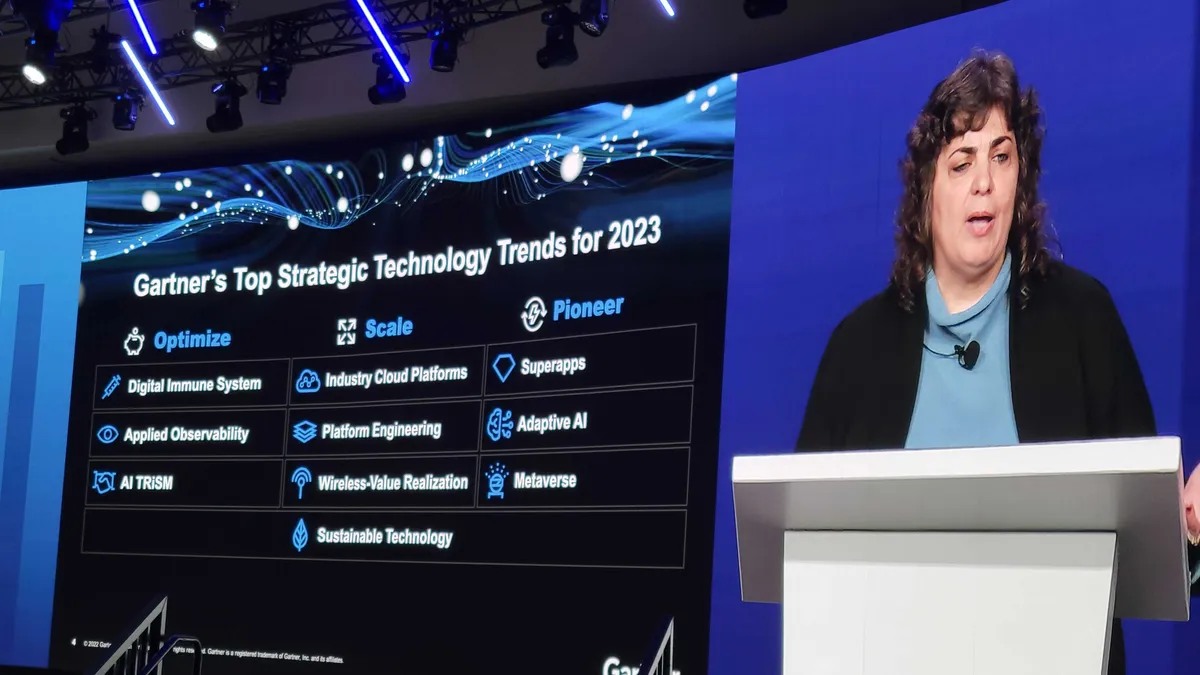Business technology has two primary edicts: cut costs through efficiency and help businesses increase revenue. It's part of the standard pitch for every vendor out there.
In Gartner's top strategic trends for 2023, emerges a new, choose-your-own-adventure approach to key shifts in technology, one that shows how businesses can use specific strategies and products to mirror overarch goals.
Some businesses are keen on cost-cutting next year, while others are expecting skyrocketing growth levels. A third group is simply reinventing themselves, said Frances Karamouzis, distinguished VP analyst at Gartner.
"The three ways that you're going to achieve this is by optimizing, scaling and pioneering," Karamouzis said.
The report, presented Monday at the Gartner IT Symposium/Xpo 2022 in Orlando, Florida, shows the evolution of technology categories over the past year. It also shows the potential for businesses that can advance technology research and invest, where appropriate, to fend off potential competitors.
But customization is key.
"A lot of these have multiple underlying technologies that need to be combined and architected together in order for the client to actually deliver on them," Karamouzis told CIO Dive. "We don't expect that a client is going to go out and do all 10."
Here are Gartner’s top strategic technology trends for 2023:
Sustainability
Sustainability, or more specifically sustainable technology, is an overarching theme through the strategic trends, as environmental and social changes rise in importance across executive agendas.
"It's really talking about all of the underlying technologies that will help focus on clients on environmental elements, governance and social," she said.
Traceability, analytics, renewable energy and AI are among the tools part of this group.
Metaverse
A contender for most hyped term of 2022, the "metaverse" can mean different things to different people.
Gartner, in its trends, defines it as a collective virtual 3D shared space, "created by the convergence of virtually enhanced physical and digital reality." Despite a large marketing push from Facebook parent company Meta, the analyst firm is projecting this space won't be owned by a single vendor.
Over the next five years, Gartner predicts 2 in 5 large organizations will combine Web3, AR cloud and digital twins to launch metaverse-based projects that seek to increase revenue.
It's the technology's first inclusion in the annual trend list.
Superapps
Half of the world population is expected to be a daily active user of multiple superapps by 2027, according to Gartner. But what is a superapp?
"A superapp combines the features of an app platform and an ecosystem all in one," said Karamouzis. "It has its own set of functionalities, but it's also a platform for third parties to develop and publish their own mini apps on it."
In other words, a superapp can consolidate and replace multiple apps for customers or employees.
"It's a game changer in terms of what's available to the end users, but it's also a game changer as to the branding," Karamouzis said.
Adaptive AI
Current AI systems must be trained on data from the past to ensure accuracy, which becomes a challenge when conditions quickly shift.
But adaptive AI, Gartner suggests, will be able to use real-time feedback and shift its learnings dynamically, adjusting goals as needed.
Digital immune system
Security is a top priority for technology executives, no matter their industry vertical.
In a digital immune system, data-driven insight helps improve operations, automate incident resolution and increase the stability of systems.
"What this is meant to do is take the concepts of observability, augmented testing, chaos engineering, auto remediation, site reliability, and package it up into a preconfigured element for all of the developers so they're optimizing the resiliency of the of the application platforms that they're putting out," said Karamouzis.
Applied observability
This strategy lets companies take observable artifacts — logs, traces or API calls — and take an integrated approach to accelerate decision making.
"When planned strategically and executed successfully, applied observability is the most powerful source of data-driven decision-making," Karamouzis said in the trends announcement.
AI trust, risk and security management
This framework is specific to all AI algorithms as well as models that operate underneath AI, and essentially deals with the issues that could compromise AI models or data by integrating those controls inside the model.
TRiSM, as Gartner refers to it, takes trust, risk and security management inside the model "so it's self testing for new things that are coming into the environment," Karamouzis said.
Industry cloud platforms
A mix of SaaS, PaaS and IaaS will equip companies with industry-specific sets of modular capabilities to support the use cases needed by specific industry business.
For years, providers have sought to address industry-specific needs, from Microsoft to AWS.
The use of these platforms will accelerate, with Gartner predicting that half of enterprises will use industry cloud platforms by 2027.
Platform engineering
Platform engineering lets companies build and operate self-service developer platforms for software delivery and life cycle management, according to the report.
Four in five companies will establish platform teams by 2026, the firm predicts. The approach will allow companies to optimize the developer experience and accelerate customer value delivery.
Wireless value realization
Proponents of 5G technology billed it as a potential enterprise technology disruptor. And while applications in specific areas have shown value, Gartner expects no single technology will dominate the landscape of wireless solutions needed.
This trend is "all about how you extend the network and the endpoints around all of the different wireless technologies," said Karamouzis. "So it's a spectrum of wireless solutions for a lot of different environments" and pure connectivity.
They will provide insight using built-in analysis and low-power systems will harvest energy directly from the network. This means the network will become a source of direct business value.






















